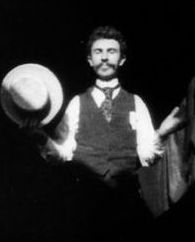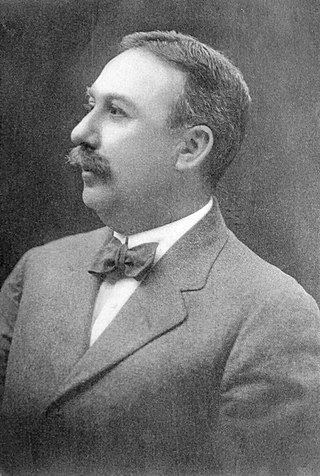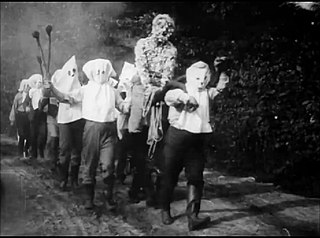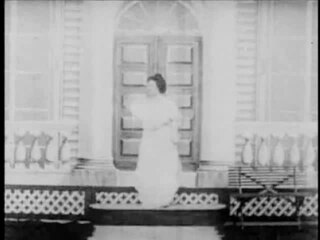
William Kennedy Laurie Dickson was a British inventor who devised an early motion picture camera under the employment of Thomas Edison.

The Great Train Robbery is a 1903 American silent film made by Edwin S. Porter for the Edison Manufacturing Company. It follows a gang of outlaws who hold up and rob a steam locomotive at a station in the American West, flee across mountainous terrain, and are finally defeated by a posse of locals. The short film draws on many sources, including a robust existing tradition of Western films, recent European innovations in film technique, the play of the same name by Scott Marble, the popularity of train-themed films, and possibly real-life incidents involving outlaws such as Butch Cassidy.
The Genie Awards were given out annually by the Academy of Canadian Cinema and Television to recognize the best of Canadian cinema from 1980–2012. They succeeded the Canadian Film Awards.

Edwin Stanton Porter was an American film pioneer, most famous as a producer, director, studio manager and cinematographer with the Edison Manufacturing Company and the Famous Players Film Company. Of over 250 films created by Porter, his most important include What Happened on Twenty-third Street, New York City (1901), Jack and the Beanstalk (1902), Life of an American Fireman (1903), The Great Train Robbery (1903), The European Rest Cure (1904), The Kleptomaniac (1905), Life of a Cowboy (1906), Rescued from an Eagle's Nest (1908), and The Prisoner of Zenda (1913).

The Night Before Christmas is a 1905 American silent short film directed by Edwin S. Porter for the Edison Manufacturing Company. It closely follows Clement Clarke Moore's 1823 poem Twas the Night Before Christmas, and was the first film production of the poem.
Charles John Musser is a film historian, documentary filmmaker, and a film editor. Since 1992, he has taught at Yale University, where he is currently a professor of Film and Media Studies as well as American Studies and Theater Studies. His research has primarily focused on early cinema, and topics such as Edwin S. Porter, Oscar Micheaux, race cinema of the silent era, Paul Robeson, film performance, as well as a variety of issues and individuals in documentary. His films include An American Potter (1976), Before the Nickelodeon: The Early Cinema of Edwin S. Porter (1982) and Errol Morris: A Lightning Sketch (2014).
Wallace McCutcheon Sr. was a pioneer cinematographer and director in the early American motion picture industry, working with the American Mutoscope & Biograph, Edison and American Star Film companies. McCutcheon's wealth of credits are often mixed up with the small handful of films directed by his son, Wallace McCutcheon Jr. (1884–1928).

Execution of Czolgosz with Panorama of Auburn Prison is a 1901 silent film produced by the Edison Studios arms of Edison Manufacturing Company. The film is a dramatic reenactment of the execution of Leon Czolgosz by electric chair at Auburn Correctional Facility following his 1901 conviction for the assassination of William McKinley. It is considered an important film in the history of cinema.
Waiting at the Church is a 1906 American silent film directed by Edwin S. Porter for the Edison Manufacturing Company.

Kansas Saloon Smashers is a 1901 comedy short film produced and distributed by Edison Studios. Directed by Edwin S. Porter, it is a satire of American activist Carrie Nation. The film portrays Nation and her followers entering and destroying a saloon. After the bartender retaliates by spraying Nation with water, policemen order them out; the identities of the actors are not known. Inspiration for the film was provided by an editorial cartoon which appeared in the New York Evening Journal.

Rube and Mandy at Coney Island was produced, directed, shot and edited by Edwin S. Porter Copyrighted on August 13, 1903, the 725 ft., 35mm film lasted roughly 10 minutes if projected at 20 frames per second.

Uncle Josh at the Moving Picture Show is a 1902 American short silent comedy film directed by Edwin S. Porter, featuring a naive spectator trying to interact with films projected onto a screen. It is an almost identical remake of a British 1901 film directed by Robert W. Paul, The Countryman and the Cinematograph. This film was the first to feature a film shown within a film.

The Child Stealers also known as The Kidnapped Child or Child Stealing is a 1904 British silent crime film about kidnapping, directed by William Barker and produced by the Warwick Trading Company.

The White Caps is a 1905 American silent drama film, directed by Wallace McCutcheon and Edwin S. Porter showing how a man abusing his wife is punished by a group of white-hooded men. It is one of the first American films exposing conjugal violence against women and showing the action of vigilante groups.

The Train Wreckers is a 1905 American silent drama film, directed by Edwin S. Porter showing how the daughter of a railway switchman and lover of a locomotive engineer is defeating outlaws trying to derail a train.

The Seven Ages is a 1905 American silent comedy film, directed by Edwin S. Porter inspired by the monologue All the World's a Stage in William Shakespeare's comedy As You Like It.

What Happened in the Tunnel is a 1903 silent short film starring Bertha Regustus and Gilbert M. Anderson. The film was directed and shot by Edwin S. Porter, produced by Edison Mfg. Co., and distributed by Edison Mfg. Co. and Kleine Optical Co.

The 'Teddy' Bears is an American silent film directed by Edwin S. Porter and Wallace McCutcheon, and produced by the Edison Manufacturing Company starting as the fairy tale Goldilocks and ending as a political satire of United States President Theodore Roosevelt.

The Trainer's Daughter; or, A Race for Love is an American silent film directed by James Searle Dawley and Edwin S. Porter, and produced by the Edison Manufacturing Company.

The Whole Dam Family and the Dam Dog is a 1905 silent short comedy film directed by Edwin S. Porter for the Edison Manufacturing Company. The five-and-a-half minute film was an adaptation of a popular picture postcard featuring a humorously named family. The film introduces each member of the Dam family, and then shows a raucous dinner scene that ends with the Dam dog pulling the tablecloth off the table, and ruining the Dam meal.




















